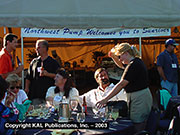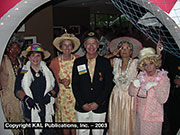
September 2003 Issue Highlights
For more complete coverage, send us an e-mail to
request a back issue.

For more complete coverage, send us an e-mail to
request a back issue.

Northwest Pump CustomerAppreciation BBQ

Oregon Petroleum Marketers Association Convention

Colorado Wyoming Petroleum Marketers Association Convention

Bio-Diesel Relay
Want to see the photos that didn't make the issue? Check out
the Cutting Room
Floor.
Phoenix Stations Run Out of Gasoline When Rupture Shuts Kinder Morgan Pipeline
Fuel-All Acquires U.S. Fleet Services Western Assets
ChevronTexaco Gets Havoline Brand
San Diego Opens Fuel Depot to Public
CEC Rejects Gulf Coast Pipeline
PHOENIX, AZ. —Gasoline shortages, long lines, and price spikes were the norm in mid-August after Kinder Morgan was forced to shut down its pipeline to Phoenix.
Kinder Morgan reported at the end of July that there was a problem with the pipeline, which runs from El Paso to Phoenix, due to a rupture in part of the line between Tucson and Phoenix. After trying to repair the pipeline, Kinder Morgan was forced to shut down the pipeline outright on August 8.
The 8" Kinder Morgan line supplies approximately 30% of the gasoline used in the greater Phoenix area or approximately 2.2 million gallons of motor fuel per day.
As soon as the pipeline was shut down, marketers were scrambling to find sources of supply.
Kinder Morgan increased the product available from its Tucson terminal. Jobbers and major oil companies immediately began trucking in product from the terminal 250 miles away but the amount available could not meet demand.
Some jobbers began trucking fuel in from Los Angeles and Dallas in an attempt to keep their stations open.
As the supply problem continued, more and more stations began running out of gasoline or running low on supplies. Local papers and news stations began running listings of stations that were out of gasoline. What had been considered a spot shortage was now considered a crisis.
Phoenix locals reported motorists waiting in line for hours for the opportunity to fill their vehicles with fuel. In many instances, customers would wait only to be told that the station had run out of gasoline while they were in line.
Phoenix police reported that they were getting a spike in calls from around gasoline stations where tempers were running high, traffic was bad and there was "the occasional fist-fight." Three Mesa police officers were called in to keep the peace at a Chevron station after the location ran out of fuel.
Operators of the stations did what they could for their customers. Employees at Danny's Carwash on Scottsdale Road handed out donuts to customers who were looking for gasoline at its Texaco-branded pumps, asking them to come back later.
While tempers flared at some locations, most customers were philosophical about the situation. Dennis Douthit of Scottsdale told local reporters that "This makes you appreciate what we've got normally. I was pretty young but I remember the oil embargo and my Dad delivering barrels of diesel fuel to people in his truck."
With supply down and transportation costs skyrocketing for the fuel that was available, gasoline prices began rising substantially in Arizona, with a ripple effect across the West — primarily in California which was sending its gasoline to Phoenix to help with the supply crisis.
By mid-August, Kinder Morgan reported that 85% of the total volume it typically transports to Phoenix was being delivered via their West Line pipeline from Los Angeles into the Valley.
The U.S. Energy Information Administration reported that the draw on gasoline from Los Angeles put pressure on supplies throughout California. This, in turn, caused California to look for supply outside its borders, increasing prices and reducing supply across the West.
As consumers in Phoenix accused stations of gouging because their prices were rising, dealers tried to explain the situation in terms of supply and demand. "They're paying $2.05 wholesale," stated Luz Rubio, executive director of the Southwest Automotive Trades Alliance. "They have to pay credit card fees on top of that. They've been closed down because they didn't have any product to sell. What are they supposed to do?"
Some dealers, responding to the lack of supply and public clamor for gasoline, followed the rules of supply-and-demand and increased their prices. However, there were immediate charges of price gouging leveled against the stations.
Dealers that posted the high prices said that they were simply responding to the economics of the situation. One Phoenix dealer stated, "I raised my prices. Of course, I did. It was expensive to get the gasoline for my station and drivers wanted it at any price. They were happy to have the gas. They would have paid $10 per gallon. Do they want me sell it for a nickel margin and be out of gas instead?"
One driver, Rosemarie Stryjewski of Phoenix, told local reporters that "I have to have gas for my job. I drive all day. I didn't mind paying $3.79 a gallon because I was able to pull right in. You gotta do what you gotta do and now I'm good to go."
Outside of the Phoenix valley, the shortage became a windfall for some service station operators. "We are really swamped with people from Phoenix," reported Rodisha Alverado, the manger at the Fast Stop, just north of Florence, AZ. Alverado said business at the station was triple during the shortage because they were able to get fuel. "They have been spending all of their old change and old bills to get gas," she reported. "I have no idea why they were cashing in silver coins and silver certificates. There is a real panic out there."
By August 21, the Arizona Department of Weights and Measures reported that only 44% of the 700 stations in the Phoenix valley were open and stocked with fuel.
The Arizona government took action to try and deal with the situation.
Arizona Governor Janet Napolitano successfully lobbied the Federal EPA to suspend the oxygenated fuels requirement for Phoenix for 30 days. This gave the state access to more sources of supply.
In addition, the DOT and the Arizona Department of Public Safety granted Arizona truckers an increase in allowable hours on the road. This allowed trucking companies more time to bring in fuel from outside states as well as restock empty gasoline stations looking for fuel shipments.
Fuel trucks were also allowed to use freeway carpool lanes to shorten their delivery times.
With the change in the regulations, marketers and trucking companies recruited drivers from New Mexico, California, and Nevada to deliver gasoline to the state, helping to ease some of the supply difficulties.
Napolitano and government officials also urged Phoenix residents to restrict their driving, use public transportation, and avoid out-of-town driving trips to decrease demand for gasoline.
Kinder Morgan tried throughout the month to repair the rupture but when tests of the line proved unsuccessful they decided to create a bypass, using an existing pipeline used to take jet fuel from Phoenix to Tucson.
Petroleum began running through the re-routed pipeline on August 24. The Arizona Department of Weights and Measures reported that by that afternoon, more than 85% of the stations in the Phoenix valley were open and stocked with fuel.
The by-pass is a temporary solution, however, because the pipeline has a capacity of approximately 35,000 barrels per day, about half the capacity of the ruptured pipeline.
Kinder Morgan President Tom Bannigan said, "We have been working non-stop to increase gasoline volumes to our Arizona customers, with safety as our top priority." He predicted that the company will be able to move increasing amounts of fuel into the Phoenix valley which would "soon eliminate" the necessity of trucking in fuel from Tucson.
The pipeline cannot resume operation until it receives a safety certification from the Arizona Corporation Commission and the U.S. Department of Transportation's Office of Pipeline Safety, which is overseeing testing of the line.
As the situation is not "fixed," gasoline prices remain high in the Valley. The Arizona AAA reported the average price for regular unleaded on Aug. 25 was $2.10 per gallon. This was an increase of 56 cents from Aug. 7, the day before the pipeline was shut down.
California gasoline prices continued to stay high as well, with insufficient time to stabilize. On the same date, San Diego's average price for unleaded regular was $2.11 per gallon. California's state-wide average was $2.07 while Arizona's was $1.97.
What is the aftermath of the Phoenix supply problem for Arizona and the West?
Kinder Morgan, who is still working on repairing the ruptured pipeline, says it will replace close to 12 miles of the existing pipeline with larger pipe. When linked with other expansions, Kinder Morgan officials say the larger pipeline will increase the capacity of the line from Tucson to Phoenix by 73% to 104,000 barrels per day. Company officials believe that boosting the capacity of the pipeline into Phoenix might help alleviate any future problems.
Some Arizona residents are calling for increased government supervision and regulation of the fuel industry. Attorney Bernie Rethore of Paradise Valley, AZ., told local reporters that "The government should have been paying attention. Somebody should have been minding the store. If they are going to let a private company provide the only source of this commodity, then there has to be monitoring."
Governor Napolitano said publicly that Kinder Morgan erred by not having a backup plan in place. She also charged that the pipeline company provided "incomplete information" to her office during the gasoline shortage. Although Kinder Morgan has complied with her request to provide all its invoices and records during the shortage period, she said the Arizona Attorney General's office is still reviewing the paperwork.
Napolitano said that she is going to use the situation to push for anti-price gouging legislation. She said she was taking this stand after she heard that some stations were "taking advantage" of the situation by charging close to $5.00 per gallon.
Arizona Attorney General Terry Goddard said that he has already drafted an anti-price-gouging bill for the states. He said that is would be up to the legislature to define gouging but he is suggesting a 10-25% increase over prices during the month before an emergency.
Not everyone in Arizona government is jumping on the bandwagon. State Senate President Ken Bennett (R-Prescott) said that he believes most gasoline stations acted "fairly" during the crisis, raising their prices because of increased wholesale costs. "The best tool against price gouging is competition and information," concluded Bennett.
LONG BEACH, CA. — Mobile fueling company U.S. Fleet Services has closed its operations, effective as of June 30, and the assets of the company have been acquired by three existing industry firms.
Quick Fuel, based in Wisconsin, has acquired the U.S. Fleet Services territory in the Midwest in conjunction with its cardlock distribution network. Taylor Oil Company has acquired the U.S. Fleet Services operations in the Northeast. However, the lion's share of the operations — in terms of geographic area — has been acquired by Fuel-All, based in Long Beach, CA.
"We purchased the Western Regional division," said Fuel-All President Dwaine Walker. "That includes everything west of the Rockies as well as the Colorado territory. In addition, we have the territory that goes through the Sunbelt, including Louisiana, Arkansas, North Carolina, South Carolina, Missouri, and some sites in Alabama, Florida, and south Texas."
Included in the deal were U.S. Fleet Services' trucking fleet as well as the company's book of business. The U.S. Fleet Services employees have been rehired by Fuel-All's licensees.
"We have doubled the size of our network," said Walker. "Fuel-All has now become the only national network of licensees providing mobile on-site fueling. We don't own any trucks as a network — we resell them to our licensees and jobbers for the communities in which they service."
"It's really been a challenge to go from a West Coast-oriented organization," continued Walker. "We've always been nationwide but this really filled in the gaps. It's allowed us to expand our truck authorization technology to distributors servicing their communities across the country."
SAN RAMON, CA. — ChevronTexaco announced that it has gained the rights to the Havoline and Texaco Xpress Lube brands worldwide.
The two brands were in play after August 13 when licensing agreements with Equilon and Motiva Enterprises expired.
ChevronTexaco's acquisition of the brand "mark a new era for the Havoline brand as it will now be managed by a single company that is totally dedicated to its success as a top oil brand in the U.S. and worldwide," said Craig Duncan, vice president of ChevronTexaco Global Lubricants. "The strength and popularity of the Havoline brand is key to CTGL's position as a premier provider of lubricant solutions."
Duncan said that ChevronTexaco will actively promote the brand with new print and radio ads as well as regional promotions for mass merchandisers and auto parts stores.
ChevronTexaco said it is also creating a marketer incentive program to promote the brand.
SAN DIEGO, CA. — A new "fuel depot," offering both traditional and alternative fuels to motorists, has opened in San Diego in August.
The 1.65 acre Regional Transportation Center (RTC) markets nine types of motor fuel to the public, including six alternative fuels: LPG, E-85, biodiesel, CNG, electricity, and ultra-low sulfur diesel. Three standard grades of gasoline are also available at the site.
The LPG tank at the San Diego site is reportedly the first public UST in the country for automobile fueling.
The biodiesel at the site is manufactured from recycled french fry grease from area restaurants.
The CNG is stored at 3,600 psi for ease of dispensing at the site.
"We are very excited that the RTC Fuel Depot has opened and is able to accommodate virtually any type of alternative or conventional vehicle in San Diego," said Mike Lewis, general manager of the RTC. "The Fuel Depot represents the important first component of the RTC, which will be the world's first comprehensive showcase of alternative fuels and the vehicles that use them."
In addition to offering a futuristic blend of fuels, the RTC utilizes futuristic design elements in its architecture and design. The 92,000 square foot facility includes Gilbarco's 8-foot-tall Eclipse dispensers, and an alternative fuel vehicle showroom, rental center, and a service center to maintain both alternative fuel and gasoline-fueled vehicles.
Lewis said motorists who choose to fill-up at the site will get the "white glove" full service treatment at no charge from RTC service attendants dressed in 1950's era uniforms who will assist with air, water and window cleaning services.
The $15 million fueling center has been in the permitting process since 1998 and under construction for the past year. Lusardi Construction served as the general contractor for the RTC and the GTB Company of El Cajon, CA., built the fueling facility.
The RTC has received financial support from Pearson Ford, Ford Motor Company, U.S. Department of Energy, California Air Resources Board, City of San Diego via a HUD grant, Mutual Propane and Clean Energy. In addition, Ford Motor Company has donated $1.4 million to create RTC Education Center as part of the alternative fuels service center "to educate middle and high school students about innovative technologies that will improve the environment."
The RTC Fuel Depot is located at 4001 El Cajon Boulevard at the intersection of El Cajon Blvd. and the I-15 and is open 24 hours a day.
SACRAMENTO, CA. — While consumers are voicing their displeasure about gasoline higher prices and Gubernatorial candidates are complaining about limited sources of supply, the California Energy Commission has decided to deny the extension of a pipeline that would bring refined products from Texas into California.
Members of the CEC unanimously decided that the Gulf Coast area would not have enough supply of gasoline to make it worthwhile to extend a pipeline from Texas to California.
The California Commissioners recommended, however, that the Longhorn pipeline, currently proposed to run between Houston and El Paso, Texas, be extended to Phoenix, AZ., and Las Vegas, NV.
The Commissioners stated that by receiving more fuel from Texas and the Gulf Coast, Arizona and Nevada could help with supply problems in California.
"Today Arizona gets nearly 70% of its gasoline from California," said California Energy Commissioner James Boyd. "By increasing the pipeline from El Paso to Phoenix, we can decrease Arizona's dependence on West Coast refineries and use our state's refinery capacity to make more California gasoline.
Originally published in the September 2003 issue of O&A Marketing News.
Copyright 2003 by KAL Publications Inc.
Serving the 13 Western States, the World's Largest Gasoline, Oil, Fuel, TBA and Automotive Service Market